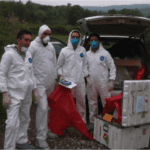 The Viral and Zoonotic Diseases Research Program (VZDRP) at the U.S. Naval Medical Research Unit No. 3 (NAMRU-3) recently completed a project started three years ago in Bulgaria on hantavirus surveillance in humans and rodents. This project supported the international agreement on International Health Regulations to prevent and control the spread of disease in developing countries by strengthening their capacity for surveillance and control.
The Viral and Zoonotic Diseases Research Program (VZDRP) at the U.S. Naval Medical Research Unit No. 3 (NAMRU-3) recently completed a project started three years ago in Bulgaria on hantavirus surveillance in humans and rodents. This project supported the international agreement on International Health Regulations to prevent and control the spread of disease in developing countries by strengthening their capacity for surveillance and control.
Hantaviruses, whose natural reservoirs are wild rodents, cause hemorrhagic fever with renal syndrome in many parts of the world. New virus strains are continuously being discovered.
The NAMRU-3 project began with a hospital-based study on acute febrile illness cases. Samples were collected from febrile patients from five hospitals in Bulgaria.
“Through GEIS (DoD Global Emerging Infections Surveillance and Response System) funding, NAMRU-3 established a state-of-the-art molecular and serologic diagnostic lab in Sofia’s National Center for Infectious and Parasitic Diseases (NCIPD) for screening the acute febrile illness (AFI) samples,” said Dr. Emad Mohareb, NAMRU-3’s principal investigator on this effort. “NAMRU-3 provided equipment and training to their eager Bulgarian collaborators, which included biosafety training, lab processing of tissues and rodent collection procedures.”
With NAMRU-3 providing periodic quality assurance/quality control and proficiency testing support to the NCIPD, one hantavirus species named Dobrava was identified as the main hantavirus species in human serum samples in Bulgaria.
The next phase of the project was to confirm the reservoir host. VZDRP’s Dr. Emad Mohareb and Mustafa Abdel Aziz, NAMRU-3 Animal Research Department’s Dr. Fady Guirguis, and Bulgarian research collaborators conducted rodent surveillance and trapped several species of rodents in areas with documented human cases.
Working with their Bulgarian collaborator, Dr. Iva Christova from the NCIPD, and other researchers from the Ministry of Health and the University of Plovdiv, the team identified trapping sites in southern Bulgaria and Burgas in eastern Bulgaria.
On two successive nights each month, rodents were trapped. Temperature, humidity and GPS coordinates were recorded. The team trapped 752 rodents and identified 13 different rodent species. Using testing by polymerase chain reaction, the investigators determined that the yellow-necked mouse (A. flavicolis) is the most common reservoir for the virus, and species identification has verified the circulation of only Dobrava hantavirus in villages where the rodents were collected.
The collaborative partnership of NAMRU-3 and the Bulgarian health and research institutions has gone a long way to strengthen the country’s public health surveillance network and better equip them to readily detect future hantavirus outbreaks in the human population.
Capt. Buhari Oyofo, NAMRU-3 commanding officer, concluded, “This is why NAMRU-3 is focused on building medical capacities in developing countries to help in pathogen detection and enhance quality of life.”
Image: NAMRU-3 and Bulgarian researchers trap rodents as part of hantavirus surveillance in humans and rodents (NAMRU-3 Public Affairs)
Article printed with permission from Naval Medical Research Center.


